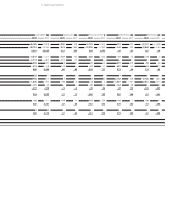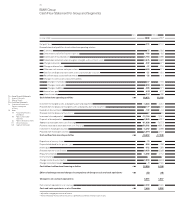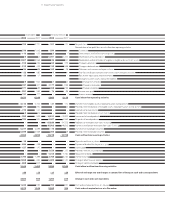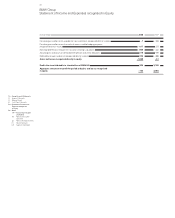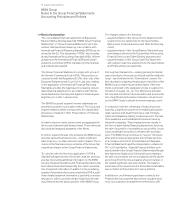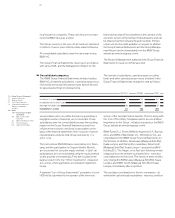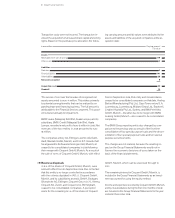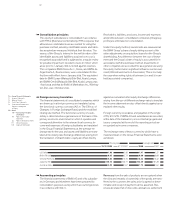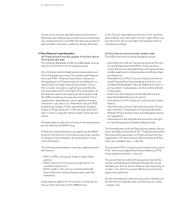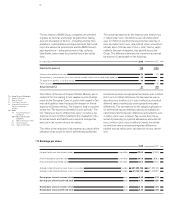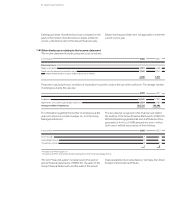BMW 2008 Annual Report Download - page 82
Download and view the complete annual report
Please find page 82 of the 2008 BMW annual report below. You can navigate through the pages in the report by either clicking on the pages listed below, or by using the keyword search tool below to find specific information within the annual report.83 Group Financial Statements
discount and rebates. In the case of long-term construc-
tion work, revenues are generally recognised in accord-
ance with IAS (Revenue) and IAS (Construction Con-
tracts) on the basis of the stage of completion of work
performed using the “percentage of completion” method.
Revenues also include lease rentals and interest income
from financial services.
If the sale of products includes a determinable amount for
subsequent services (multiple-component contracts), the
related revenues are deferred and recognised as income
over the period of the contract. Amounts are normally rec-
ognised as income by reference to the expected pattern of
related expenditure.
Profits arising on the sale of vehicles for which a BMW Group
company retains a repurchase commitment (buy-back
contracts) are not recognised until such profits have been
realised. The vehicles are included in inventories and stated
at cost.
Cost of sales comprises the cost of products sold and the
acquisition cost of purchased goods sold. It includes all
directly attributable material and production costs and pro-
duction overheads, including depreciation/amortisation
of property, plant and equipment and intangible assets re-
lating to production and write-downs on inventories. Cost
of sales also includes freight and insurance costs relating
to deliveries to dealers and agency fees on direct sales.
Expenses which are directly attributable to financial services
business and interest expense from refinancing the entire
financial services business, including the expense of risk
provisions and write-downs, are reported in cost of sales.
Research costs and development costs which are
not capitalised are recognised as an expense when in-
curred.
In accordance with IAS (Accounting for Government
Grants and Disclosure of Government Assistance), public
sector grants are not recognised until there is reasonable
assurance that the conditions attaching to them have been
complied with and the grants will be received. They are
recognised as income over the periods necessary to match
them with the related costs which they are intended to
compensate.
Basic earnings per share are computed in accordance
with IAS (Earnings per Share). Undiluted earnings per
share are calculated for common and preferred stock by
dividing the net profit after minority interests, as attributa-
ble to each category of stock, by the average number of
outstanding shares. The net profit is accordingly allocated
to the different categories of stock. The portion of the
Group net profit for the year which is not being distributed
is allocated to each category of stock based on the number
of outstanding shares. Profits available for distribution are
determined directly on the basis of the dividend resolutions
passed for common and preferred stock. Diluted earnings
per share would have to be disclosed separately.
Purchased and internally-generated intangible assets are
recognised as assets in accordance with IAS (Intangible
Assets), where it is probable that the use of the asset will
generate future economic benefits and where the costs of
the asset can be determined reliably. Such assets are
measured at acquisition and/or manufacturing cost and, to
the extent that they have a finite useful life, amortised on a
straight-line basis over their estimated useful lives. With
the exception of capitalised development costs, intangible
assets are generally amortised over their estimated useful
lives of between three and five years. Intangible assets
with finite useful lives are assessed regularly for recovera-
bility and their carrying amounts are reduced to the recov-
erable amount in the event of impairment.
Development costs for vehicle and engine projects are
capitalised at manufacturing cost, to the extent that costs
can be allocated reliably and both technical feasibility and
successful marketing are assured. It must also be prob-
able that the development expenditure will generate future
economic benefits. Capitalised development costs com-
prise all expenditure that can be attributed directly to the
development process, including development-related over-
heads. Capitalised development costs are amortised on
a systematic basis, following the commencement of pro-
duction, over the estimated product life which is generally
seven years.
All items of property, plant and equipment are considered
to have finite useful lives. They are recognised at acquisi-
tion or manufacturing cost less scheduled depreciation
based on the estimated useful lives of the assets. Depre-
ciation on property, plant and equipment reflects the pat-
tern of their usage and is generally computed using the
straight-line method. Components of items of property,
plant and equipment with different useful lives are depre-
ciated separately.


